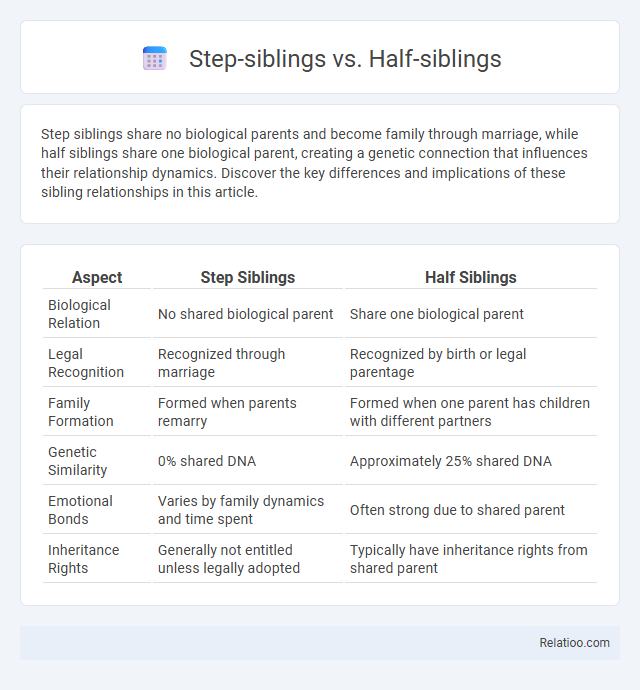Step siblings share no biological parents and become family through marriage, while half siblings share one biological parent, creating a genetic connection that influences their relationship dynamics. Discover the key differences and implications of these sibling relationships in this article.
Table of Comparison
| Aspect | Step Siblings | Half Siblings |
|---|---|---|
| Biological Relation | No shared biological parent | Share one biological parent |
| Legal Recognition | Recognized through marriage | Recognized by birth or legal parentage |
| Family Formation | Formed when parents remarry | Formed when one parent has children with different partners |
| Genetic Similarity | 0% shared DNA | Approximately 25% shared DNA |
| Emotional Bonds | Varies by family dynamics and time spent | Often strong due to shared parent |
| Inheritance Rights | Generally not entitled unless legally adopted | Typically have inheritance rights from shared parent |
Definition of Step Siblings
Step siblings are individuals related through the marriage of their respective parents, without sharing any biological connection, distinguishing them from half siblings who share one biological parent. Family unity in blended families often depends on emotional bonds and mutual respect rather than genetics, promoting harmony despite different familial structures. Understanding the definition of step siblings highlights the evolving nature of family dynamics in modern society.
Definition of Half Siblings
Half siblings share one biological parent, either the mother or the father, making their genetic connection stronger than step siblings, who are related only through marriage with no shared biological ties. Family unity often depends on emotional bonds and shared experiences rather than just biological relationships, and understanding the definition of half siblings helps clarify these family dynamics. Your connection with half siblings can influence inheritance, medical history awareness, and legal relationships within blended families.
Key Differences Between Step and Half Siblings
Step siblings share no biological parents but are connected through their parents' marriage, while half siblings share one biological parent, resulting in a closer genetic relationship. Your family unity may face unique challenges and strengths depending on whether step or half siblings are involved, as emotional bonds often develop differently in blended families. Understanding these key differences helps foster empathy and cooperation, enhancing overall family harmony and support.
Family Dynamics in Step Sibling Relationships
Step siblings often navigate unique family dynamics shaped by blended family structures, where relationships are formed through marriage rather than blood. Unlike half siblings who share biological parents and typically have more inherent familial bonds, step siblings must actively build trust, communication, and emotional connections to foster family unity. Understanding these distinctions helps promote positive interactions and cohesive family environments within step sibling relationships.
Family Dynamics in Half Sibling Relationships
Half siblings share a unique family dynamic shaped by biological connection through one common parent, which often influences emotional bonds and identity formation. Your relationships with half siblings can vary widely based on cohabitation, parental involvement, and shared experiences, impacting family unity and support systems. Navigating these dynamics requires understanding the nuances in loyalty, communication, and blended family roles to foster stronger, cohesive family ties.
Legal Considerations and Rights
Step siblings do not share biological parents, so legal rights related to inheritance or custody are typically not automatic and depend on specific jurisdictional laws or formal adoption processes. Half siblings share one biological parent, which often grants them statutory rights concerning inheritance, custody, and family medical information under most legal systems. Understanding your family's legal framework is crucial to protecting your rights and fostering family unity amid complex relational dynamics.
Emotional Impact on Children
Step siblings and half siblings experience family unity differently, shaping the emotional impact on children in unique ways. Your child may face challenges integrating into blended families with step siblings, requiring trust-building and shared experiences to foster emotional bonds. Half siblings, sharing biological ties, often have a deeper innate connection which can enhance emotional security and family cohesion.
Blended Families and Social Perception
Step siblings and half siblings both play pivotal roles in blended families, yet they differ fundamentally in biological connection--step siblings share no genetic link while half siblings share one parent. Social perception often favors half siblings due to their blood relation, which can influence family unity dynamics and emotional bonds. Blended families navigating the integration of step and half siblings face unique challenges in fostering equality and cohesion amid societal biases and diverse family roles.
Navigating Conflicts Between Step and Half Siblings
Navigating conflicts between step siblings and half siblings requires understanding the unique family dynamics and emotional bonds that differentiate these relationships. Step siblings share no genetic ties but are united through marriage, often leading to challenges in establishing trust and mutual respect, whereas half siblings share biological connection, which can influence their sense of identity and belonging. Family unity depends on fostering open communication, empathy, and conflict resolution strategies that honor both the individual experiences and collective harmony within blended families.
Building Strong Bonds Within Blended Families
Step siblings and half siblings often face unique challenges when forming family unity, requiring intentional efforts to build strong bonds. Emphasizing open communication, shared experiences, and mutual respect fosters trust and emotional connection within blended families. Consistent family rituals and collaborative problem-solving strategies contribute significantly to creating a cohesive and supportive family environment.

Infographic: Step Siblings vs Half Siblings
 relatioo.com
relatioo.com